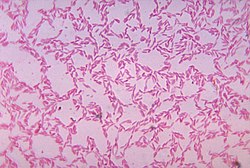El grupo FCB o el Sphingobacteria es un clado o grupo filogenético de bacterias gramnegativas que en su mayoría son anaerobias, al que se le asigna usualmente rango de superfilo. Incluye a Bacteroidota, Fibrobacterota, Gemmatimonadota y varios filos candidatos. FCB pertenece a su vez a un clado mayor: Gracilicutes. Evolutivamente se caracterizan por ser bacterias Gram negativas que desarrollaron esfingolípidos o sulfonolípidos, con amplia pérdida de flagelos, alta movilidad por deslizamiento.[1][2]
Cavalier-Smith denomina a este clado Sphingobacteria.[1] El valor filogenético de este grupo está respaldado por análisis genómico-proteicos, así como por el ARNr 16S.[3]
Filogenia
Una filogenia algo consensuada en el GTDB database y el Annotree es la siguiente:[4][5]
Otros autores consideran que Fibrobacterota forma un clado con Gemmatimonadota.[6] El filo candidato Hydrogenedentes fue incluido por estudios recientes[7] y por el NCBI,[8] aunque estudios anteriores los exluían.
Véase también
Referencias
- ↑ a b Cavalier-Smith T (2006). "Rooting the tree of life by transition analyses". Biol. Direct 1: 19. doi:10.1186/1745-6150-1-19
- ↑ Hamilton, T. L., Bovee, R. J., Sattin, S. R., Mohr, W., Gilhooly III, W. P., Lyons, T. W., ... & Macalady, J. L. (2016). Carbon and sulfur cycling below the chemocline in a meromictic lake and the identification of a novel taxonomic lineage in the FCB superphylum, Candidatus Aegiribacteria. Frontiers in microbiology, 7.
- ↑ Gupta, R. S. (2004). "The Phylogeny and Signature Sequences Characteristics of Fibrobacteres,Chlorobi, and Bacteroidetes". Critical Reviews in Microbiology 30 (2): 123–143.
- ↑ Mendler, K; Chen, H; Parks, DH; Hug, LA; Doxey, AC (2019). «AnnoTree: visualization and exploration of a functionally annotated microbial tree of life». Nucleic Acids Research 47 (9): 4442-4448. PMC 6511854. PMID 31081040. doi:10.1093/nar/gkz246. Archivado desde el original el 23 de abril de 2021. Consultado el 21 de julio de 2021.
- ↑ «GTDB release 05-RS95». Genome Taxonomy Database.
- ↑ Christian Rinke et al 2013. Insights into the phylogeny and coding potential of microbial dark matter. Nature Volume: 499, Pages: 431–437 doi:10.1038/nature12352
- ↑ Emiley A Eloe-Fadrosh et al. 2017, Global metagenomic survey reveals a new bacterial candidate phylum in geothermal springs. Nature Communications 7 · January 2016 DOI: 10.1038/ncomms1047
- ↑ NCBI Taxonomy Browser: FCB group (clade).
